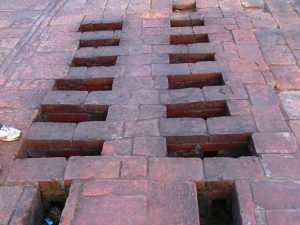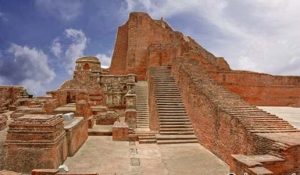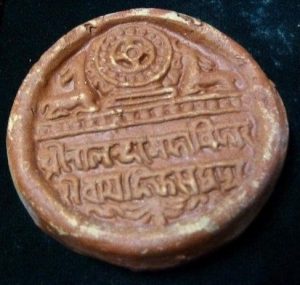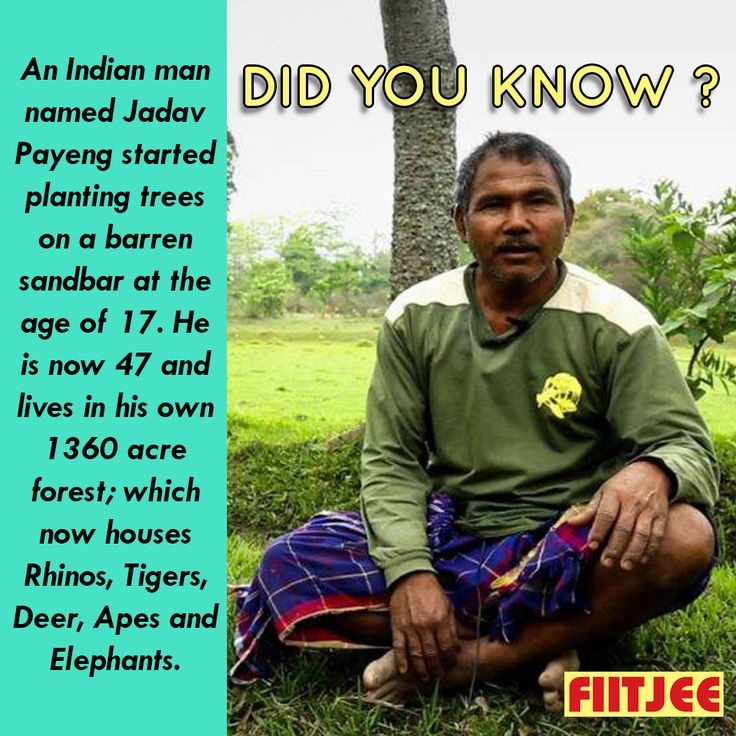The very purpose of education is to refine the thinking of humankind; the essence of education is man making and character building which in turn builds the society. Revisiting the ancient education system throws light on scientific teaching-learning processes. One such ancient Indian University was the Nalanda University, which is counted among the first few universities in world. Nalanda was established in the fifth century AD in Bihar, India. It survived until circa 1200 AD. Though it was devoted to Buddhist studies, it also trained students in fine arts, medicine, mathematics, astronomy, politics, human psychology, anthropology and the art of war. Courses were drawn from every field of learning: Buddhist and Hindu literature and culture, sacred and secular, foreign and native. Students studied science, astronomy, medicine, and logic as diligently as they applied themselves to metaphysics, philosophy, Samkhya, Yoga-shastra, the Veda, and the scriptures of Buddhism. They studied foreign philosophy likewise.
You will be surprised to know that Nalanda was one of the world’s first residential universities. It had dormitories for students. It accommodated over 10,000 students and 2,000 teachers then. It attracted pupils and scholars from Korea, Japan, China, Tibet, Indonesia, Persia and Turkey. During the period of Harsha the monastery is reported to have owned 200 villages given as grants.
Historical studies indicate that the University of Nalanda was established during the reign of the Gupta emperor Kumaragupta and a seal identifies a monarch named Shakraditya (Śakrāditya) as its founder. The university used to conduct entrance examination which was very difficult: the passing rate was 3 out of every 10 students. This is recorded in the diary of the Chinese traveler, Hien Tsang.
Nalanda was initially a prosperous village because of its location and infrastructure. It was a major trade route that ran through the nearby city of Rajgir which was then the capital of Magadha. It is said that the Mahavira (the Jain Tirthankara) spent 14 years at Nalanda. It is said that Gautam Buddha too delivered lectures in a nearby mango grove named Pavarika. This traditional association with Mahavira and Buddha slightly dates the existence of the village to at least the 5th–6th century BCE. Not much is known of Nalanda; but Taranatha, a Tibetan Lama, has stated few things about Nalanda in 17th century in his diary.
The Nalanda university was an architectural masterpiece, and was marked by a lofty wall and one gate. Nalanda had eight separate compounds and had ten temples in its location, besides many other meditation halls and classrooms. On it’s the grounds there were lakes and parks.
The Class-room system at Nalanda University
The curricula of the university offered study of abstract knowledge like Philosophy, religion, Buddhism and scientific thoughts in astronomy, mathematics, anatomy etc. in each classroom, there used to be hundreds of students and they were not allowed to go outside until the lecture was over. To add to their facility, even a well was there in most of the classroom to quench the thirst of the students if they were thirsty. There were around 8 colleges with tens of class rooms. Isn’t this astonishing!
Hostels of the students
Nalanda University was first one to offer boarding facility to its students. The whole boarding system was divided into three layers or floors of the dormitory. New students lived at the basement, middle level students at the ground and dormitory captain and more experienced students at the top floor. There was a stairway system to connect the floors. There were as many as 300 rooms. The student’s accommodation, i.e the dormitory had a well-planned ventilation system. Though there were no proper windows, fresh air and sunlight were ensured by the ventilation system at the dormitory had an opening. These openings where wide and inclined in nature to allow the air and sunlight to come in through.
Drainage system
The drainage system was also hierarchical in nature. There were main drainage system which carried the water of the whole settlement then there were smaller drainage which were from house-holds. This drainage system was more or less inspired by the Harappan culture. The bigger drains were seated deeper in the earth while the smaller drains were shallow, this was designed in such a ways that smaller drainage could flush in the bigger and dipper seated drainage.
The open cooking mud-oven called chullah
The chullah were set in the open and could be used from the both sides. A number of items could be used simultaneously  at the chullah and the chullah could be burned from both the sides. Students could use challahs to cook their food, heat their food, heat the water for bath etc. Apart from open chullahs, the cooking area also has an octagonal well which is scientifically proven now that the well somehow used the filtering system to keep the water always fresh. Besides well and open over, there were also quarters for the cooking staff and the whole cooking area formed a part of the university complex.
at the chullah and the chullah could be burned from both the sides. Students could use challahs to cook their food, heat their food, heat the water for bath etc. Apart from open chullahs, the cooking area also has an octagonal well which is scientifically proven now that the well somehow used the filtering system to keep the water always fresh. Besides well and open over, there were also quarters for the cooking staff and the whole cooking area formed a part of the university complex.
The Library
The library of Nalanda was known as Dharma Gunj (Mountain of Truth) or Dharmagañja (Treasury of Truth), those days, it was the most renowned repository of Buddhist knowledge in the world at the time. Its collection was said to comprise hundreds of thousands of volumes, so extensive that it burned for months when it was set aflame by Muslim invaders. The library had three main buildings as high as nine stories tall, Ratnasagara (Sea of Jewels), Ratnodadhi (Ocean of Jewel) It might sound amazing today, but its library was located in a nine storied building where meticulous copies of texts were produced. The center had eight separate compounds, ten temples, meditation halls, classrooms, lakes and parks. It had a nine-story library where monks meticulously copied books and documents so that individual scholars could have their own collections.
Administration
According to the writings of Yijing (a Tang dynasty Chinese Buddhist monk originally named Zhang Wenming) the matters of administration and discussion at the Nalanda University would require assembly of everybody, including the residing monks and the consensus on decision was reached jointly by everyone present in the assembly. Administrative system the University, in a way, was democratic.
The University produced some of the famous scholars who studied in Nalanda University include Harshavardhana, Dharmapal, Vasubandhu, Suvishnu, Dharmakirti, Asanga, Shantarakhsita, Aryadeva, Nagarjuna, Padmasambhava and Xuanzang.
The sad end of the beautiful university
It is said that Bakhtiyar Khilji – a Turkish Leader had fallen sick and doctors in his court failed to cure him. Then, someone advised him to get himself cured by Rahul Sri Bhadra, the principal of Nalanda University. Khilji was too proud of his Islamic culture and refused to get himself treated by a person outside his religion. But his health worsened and he was left with no other  option but to invite Bhadra from Nalanda. Khilji put a condition and asked Bhadra to cure him without any medicines. Bhadra then asked Khilji to read some pages from the Koran as a remedy to his illness and to everyone’s surprise Khilji was cured. Khilji got disturbed by the fact that an Indian scholar and teacher knew more than the doctors of his court, Khilji decided to destroy the roots of knowledge, Buddhism and Ayurveda, from the country. He set Nalanda University on fire. With the fire, the great library of Nalanda burned down nearly 9 million manuscripts. As mentioned in many records, the library was burning for months together because of the mammoth volumes of manuscripts and records it held.
option but to invite Bhadra from Nalanda. Khilji put a condition and asked Bhadra to cure him without any medicines. Bhadra then asked Khilji to read some pages from the Koran as a remedy to his illness and to everyone’s surprise Khilji was cured. Khilji got disturbed by the fact that an Indian scholar and teacher knew more than the doctors of his court, Khilji decided to destroy the roots of knowledge, Buddhism and Ayurveda, from the country. He set Nalanda University on fire. With the fire, the great library of Nalanda burned down nearly 9 million manuscripts. As mentioned in many records, the library was burning for months together because of the mammoth volumes of manuscripts and records it held.
Nalanda once again revived
The ancient university famous for its scientific teaching and learning in Bihar reopened on 1st September 2014. It began its first academic session from with 15 students, including five women, and 10 faculty members, under the leadership of Dr. Amartya Sen, the fully-residential university will be completed by 2020. It will eventually have seven schools, all for post-graduate and doctoral students, offering courses in science, philosophy and spirituality and social sciences.















































